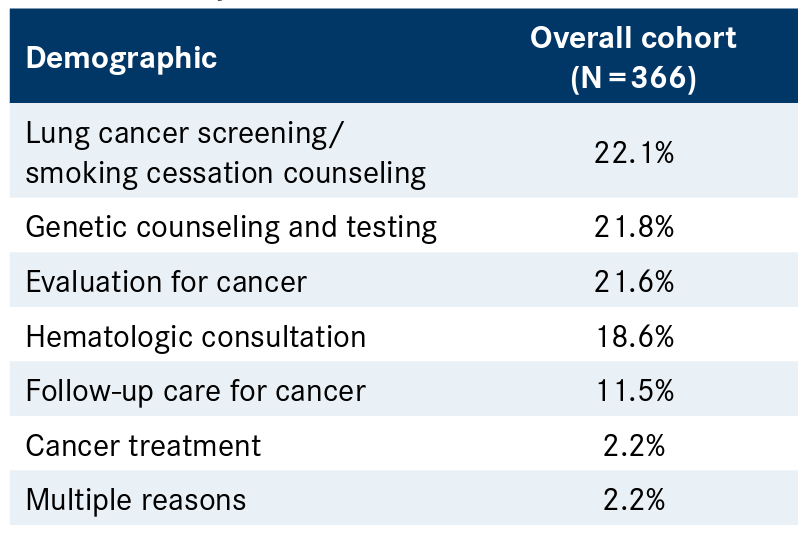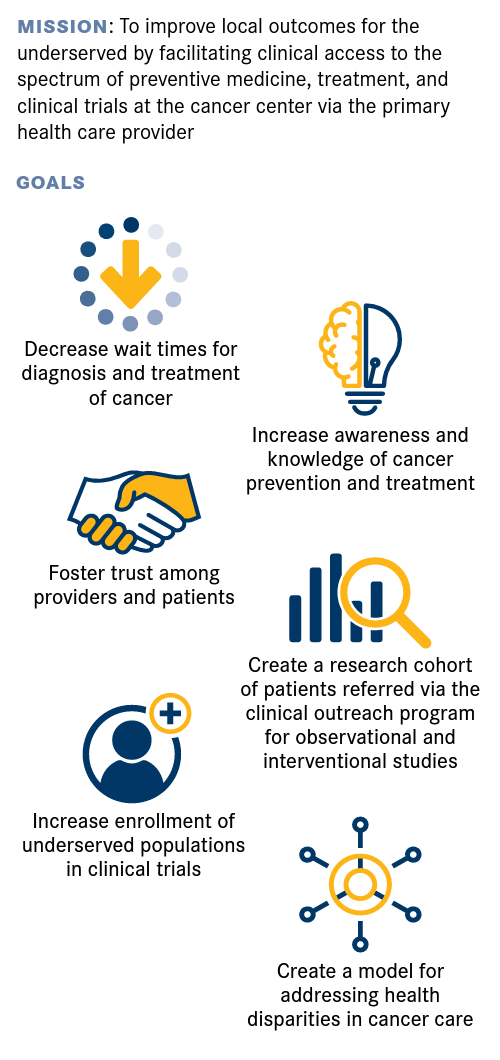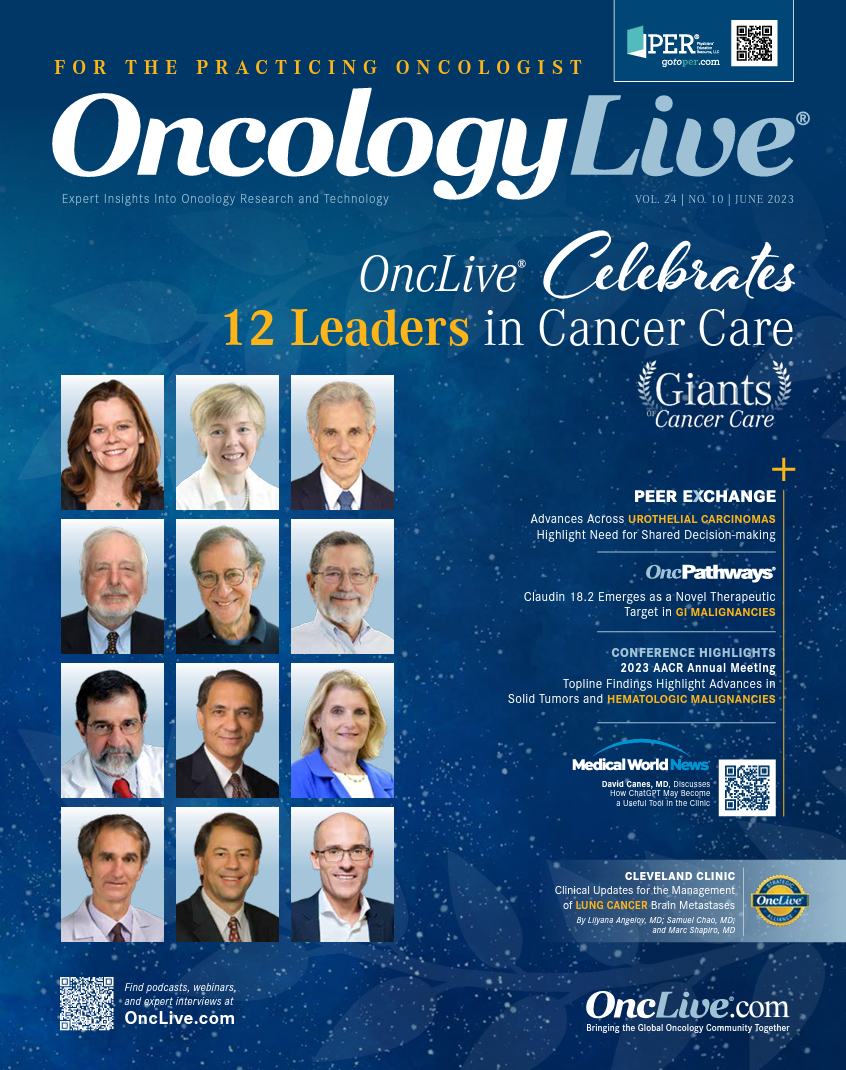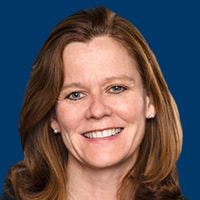Publication
Article
Oncology Live®
Colocation Approach Leads to Decreased Time to Diagnosis, Stimulates Clinician Collaboration
Author(s):
Investigators at Dana-Farber Cancer Institute in Boston, Massachusetts, developed a clinical outreach program combining diagnostic and patient navigation services.
Christopher Lathan, MD, MS, MPH

Marginalized communities historically have had difficulty accessing services from cancer centers via the community-based setting. Awareness campaigns, outreach efforts, and other smaller initiatives have not had the results needed to close the gap in helping patients with cancer get to these lifesaving services.1,2
Investigators at Dana-Farber Cancer Institute in Boston, Massachusetts, developed a clinical outreach program combining diagnostic and patient navigation services.1 By streamlining services in 1 location, clinicians sought to integrate all elements of the patient journey to enhance shared decision-making, keep referral pathways concise, and potentially offer clinical trial enrollment. Recent findings published in JCO Oncology Practice showed that the implementation of a colocation program significantly reduced the median time to cancer diagnosis, which may enhance the delivery of cancer care services in underserved communities.
Developed in 2009, the strategic cancer care equity program was created in response to a needs assessment that found cancer incidence and mortality rates to be significantly higher in the greater Boston area among historically marginalized populations such as patients of color and those of a lower socioeconomic status. Findings from the assessment also identified barriers to cancer care, including cost, perceptions of cancer, and care quality perceived as below standard.1
In the program, cancer diagnostic services and patient navigation are offered together at a federally qualified health center (FQHC). Patients are referred by primary care providers for cancer-related issues such as preventative services, diagnosis, or reestablishment with oncologists for patients with a history of cancer (Table1). Oncology nurse navigators are employed to conduct patient intake assessments, oversee scheduling, coordinate team communication, and assist with patient insurance and financial grievances.
Table. Reason for Referral in Colocation Model Study1

“We were interested in how we can impact care [in these] neighborhoods, and from a cancer center perspective, we were trying to figure out how can we decrease the time it takes…to get the cancer [diagnosis] worked up,” Christopher Lathan, MD, MS, MPH, chief clinical access and equity officer, the Christopher and Constance Hadley Family Chair, and the associate medical director of the DFCI Network at Dana-Farber, said in an interview with OncologyLive. “The impetus was to get out, be involved, and be present in the community. The idea was, if we are present and we helped with a diagnostic clinic, would that actually make a difference in outcomes? [We wanted] to see if this intervention that we hoped would give more access would also have a direct impact and make a difference in the lives of patients with cancer seen at those health centers.”
This type of colocation model previously has been applied in several community-based interventions, but there are very few examples of a colocation model being implemented at community-based diagnostic clinics for cancer care. Colocation in this instance means services are present in the same physical location without necessarily being integrated with one another. It can mean the sharing of equipment and staff, as well as coordinated services provided by health service providers. It has been hypothesized that colocation approaches can optimize access to care because the proximity of providers leads to enhanced communication and additional input in diagnostic decisions.1
The program was initiated in January 2012 at an FQHC and primary care center in Roxbury, Massachusetts. Approximately 90% of patients treated at this FQHC are in minority groups, with 91% at or below the national poverty level.
Eligible patients were adults who received cancer-related services at the Roxbury facility between January 2012 and July 2018. Patients provided informed consent in person either at the end of their visit or during a follow-up visit with their primary care provider. Importantly, patients were not required to enroll in the study to receive services through the program.
The overall cohort included in the study consisted of 366 patients, 82 of whom had a cancer diagnosis. Most were women (60.1%), spoke English (59.8%), and had Medicaid as their insurance provider (55.0%).
The primary goal of the initiative was to resolve the cancer-related clinical issue within 21 days.1 Secondary outcome measures consisted of clinical trial enrollment and financial distress as reported by study participants (Figure).2
Figure. Colocation Mission and Goals2

Findings from the study showed that the median time to diagnostic resolution for patients with a cancer diagnosis, whether it was new, existing, or prior, was 12 days (95% CI, 8-21). Comparatively, the median time to diagnostic resolution was 25 days (95% CI, 18-28) in the overall cohort and 28 days (95% CI, 21-35) for patients without a cancer diagnosis. Median time to diagnostic resolution was not significantly affected by patient race, ethnicity, sex, age, insurance, language, employment status, or education.
“Our goal was to get that median time under 21 days for [patients with] cancer,” Lathan said. “The fact that we got it down to 12 days was surprising for us; we were happy, but surprised. [Additionally], 10% of the cohort that we reported were in a cancer clinical trial, that’s higher than average for this population. Looking at a subset of patients with active cancer, that [rate of clinical trial enrollment] goes up to 24%, which is again much higher than what you’d see nationally for this group. We don’t have a great hypothesis [as to why that is,] but being exposed to our cohort study and our navigation [services] might have allowed people to build more trust.”
Additional results showed that most patients in the overall cohort presented with a comorbidity (88%). The most common comorbidities were hypertension (42.6%), psychologic disorder (37.7%), diabetes (31.4%), and gastrointestinal tract/liver disease (27.3%). In terms of insurance status, most patients (85%) had plans that were contracted with Dana-Farber. Ten percent of the overall cohort and 24% of patients with cancer were subsequently enrolled in a clinical trial taking place at Dana-Farber. All patients with a cancer diagnosis who were being actively treated for their disease (n = 9) were enrolled in a clinical trial. A majority of the patients who were enrolled in trials were Black (71%).
Patients with a new or existing cancer diagnosis were all referred to Dana-Farber. Most of these patients received a treatment plan (66%), and 29% were given a surveillance plan. Those who were lost to follow-up after displaying a prior history of cancer were all reconnected with care; 59% and 41% of these patients were given a treatment and a surveillance plan, respectively.
Limitations of the study included the relatively small cohort size and the lack of information regarding cancer care and outcomes at the FQHC prior to the program. Lathan also noted that a lack of randomization has an impact on the generalizability, sustainability, and reproducibility of the findings. Additionally, economic considerations were not included as part of the study.1
To address their study’s limitations, investigators created a system to gather longitudinal data. These findings will be used to follow project-level outcomes and eventually perform a prospective case-control analysis with another FQHC that has not yet implemented the study intervention. Notably, the intervention is currently being applied at 2 other FQHCs in the Boston area.3
“The first thing of any of these studies is proof of concept and I feel like we’ve done a good job of that,” Lathan said. “The next step is to expand to other areas and see if the same thing happens. We’ve already expanded to a couple of other FQHC partners. The second thing is to look at if this is cost-effective in our current system. I also want to start to look at some other aspects, [such as] survivorship and look at some quality metrics for the patients, providers, and others in the system. We want to get into more detail with this cohort and figure out other interactions as well as social factors and how they might impact things.”
References
- Stockman LS, Gundersen DA, Gikandi A, et al. The colocation model in community cancer care: a description of patient clinical and demographic attributes and referral pathways. JCO Oncol Pract Published online March 20, 2023. doi:10.1200/OP.22.00487
- Waldman LT, Svoboda L, Young BF, et al. A novel community-based delivery model to combat cancer disparities. Healthc (Amst). 2013;1(3-4):123-129. doi:10.1016/j.hjdsi.2013.09.004
- Cancer diagnostic services in a community health center speed diagnosis for underserved populations. News release. Dana-Farber Cancer Institute. March 20, 2023. Accessed April 12, 2023. https://www.dana-farber.org/newsroom/news-releases/2023/cancer-diagnostic-services-in-a-community-health-center-speed-diagnosis-for-underserved-populations/























%20(2)%201-Recovered-Recovered-Recovered-Recovered-Recovered-Recovered-Recovered-Recovered-Recovered-Recovered-Recovered-Recovered-Recovered-Recovered-Recovered-Recovered-Recovered.jpg?fit=crop&auto=format)
%20(2)%201-Recovered-Recovered-Recovered-Recovered-Recovered-Recovered-Recovered-Recovered-Recovered-Recovered-Recovered-Recovered-Recovered-Recovered-Recovered-Recovered-Recovered.jpg?fit=crop&auto=format)
